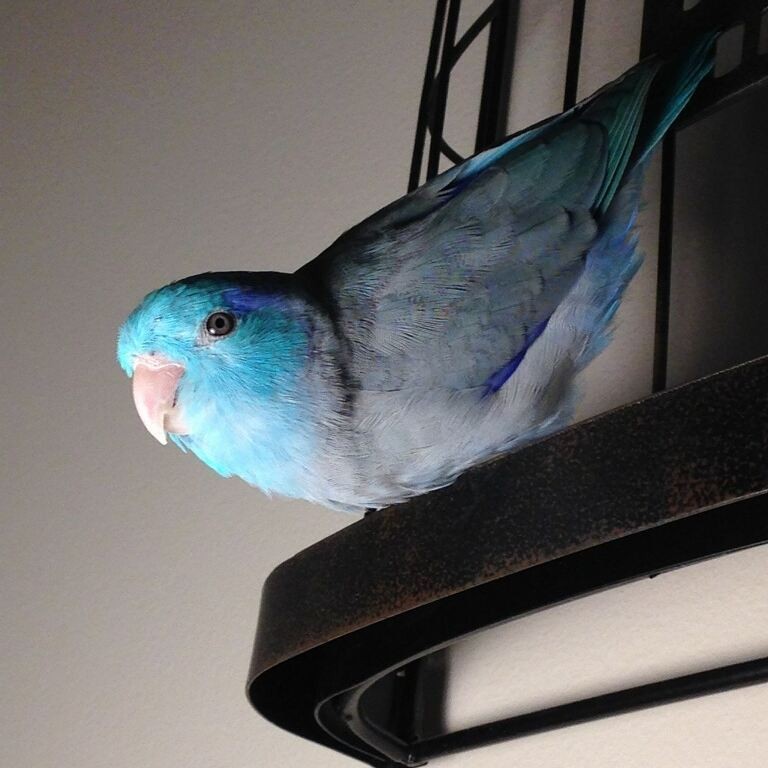Pacific Parrotlet
A species of Typical Parrotlets Scientific name : Forpus coelestis Genus : Typical Parrotlets
Pacific Parrotlet, A species of Typical Parrotlets
Botanical name: Forpus coelestis
Genus: Typical Parrotlets
Content
Description People often ask General Info
 Photo By Zaitsevx , used under CC-BY-SA-4.0 /Cropped and compressed from original
Photo By Zaitsevx , used under CC-BY-SA-4.0 /Cropped and compressed from original Description
Pacific parrotlets (Forpus Coelestis) are a small green parrot originating from South America. They are 11–14 centimetres (4.3–5.5 in) long and typically weigh 30+ grams. Wild Pacific parrotlets are green with a dusty grey cast over the body with a nice bright green mask and a pinkish beak with pinkish grey legs and feet. Pacific parrotlets are sexually dimorphic (You can sex them just by looking at them) with males sporting beautiful blue on the wings. That blue can vary in intensity from a bright cobalt blue to a pale almost lavender shade of blue on American birds and be almost non existent on marbled birds only being visible on the underside of the wing right on the joint. Male parrotlets also have blue streaks behind the eyes which is often referred to as "eyeshadow" as well as blue rumps. Female parrotlets have no blue on the wings whatsoever but can have blue eye streaks as well as a blue rump. Parrotlets are often referred to as pocket parrot because of their size but are known for their larger than life personalities and feisty attitudes. They are solitary birds in captivity due to their aggressive behavior towards other birds unless they are in a large enclosure to get away from one another so it is not suggested to keep more than one together unless they have space and never put them with other types of birds because they will attack. Although the base (wild) color of parrotlets is green they also come in a rainbow of mutations including: American Yellow, Green Marbled, American Yellow Marbled, Green Fallow, Green Fallow Marbled, American Yellow Fallow, American Yellow Marbled Fallow, Blue, American White, Blue Marbled, American White Marbled, Blue Fallow, American White Fallow, Blue Marbled Fallow, American White Marbled Fallow, Turquoise, American Turquoise, Turquoise Marbled, American Turquoise Marbled, Turquoise Fallow, American Turquoise Fallow, Turquoise Fallow Marbled, American Turquoise Fallow Marbled, Grey, American Grey, Grey Marbled, American Grey Marbled, Grey Fallow, American Grey Fallow, Grey Fallow Marbled, American Grey Fallow Marbled, Albino, Lutino Creamino, Cinnamon, Misty, Dark Factor, and Pied. There is no such thing as dilute in parrotlets and pastel was an incorrect term used for edging on the feathers and wings but the correct term is Marbled. 
Size
13 cm
Nest Placement
Cavity
Feeding Habits
Pacific Parrotlet's diet primarily consists of berries, cactus fruits, and a variety of seeds. They exhibit opportunistic foraging behaviors, adapting to available resources. Unique adaptations include a strong preference for certain fruits and vegetables, which is especially catered to in captivity with an expanded diet. Feeding occurs at various times throughout the day.
Habitat
Pacific Parrotlet are indigenous to subtropical and tropical regions of Western South America, residing in environments up to 1500 meters in elevation. Their preferred habitats include arid to semi-arid areas, with a fondness for dry forests, deciduous woodlands, and scrublands. These birds also adapt to gallery forests, secondary growth, and even human-modified spaces like gardens and agricultural fields. Pacific Parrotlet are non-migratory and tend to avoid densely vegetated areas.
Dite type
Granivorous
People often ask
General Info
Feeding Habits
Bird food type
Distribution Area
Wild Pacific parrotlets are native to western Ecuador and northwestern Peru. Most common in dry habitats such as the desert and deciduous forest, but have spread into humid areas in response to deforestation. Pacific parrotlets have also been reported in the middle Marañón valley. In 2014 a small flock of Pacific parrotlets was reported near the Rio Mataje in Nariño, southwestern Colombia. They are abundant across their range; populations are relatively undisturbed by human activity. Pacific parrotlets are found living in flocks from 40 to 50, on the borders of W lowlands and foothills, woodlands, shrubby clearings, gardens, parks, and crops (Restall & Freile, 2019, p. 208). Pacific parrotlets typically live in subtropical or tropical dry forest, subtropical or tropical moist lowland forest, subtropical or tropical dry shrubland, and heavily degraded former forest. Pacific parrotlets are non-migratory, meaning they stay in the same area year-round. 
Species Status
The Pacific parrotlet is currently listed as Least Concern by the IUCN Red List. The number of mature individuals in the wild is not known, but population size seems to be stable. 
Scientific Classification
Phylum
Chordates Class
Birds Order
Parrots Family
Parrots Genus
Typical Parrotlets Species
Pacific Parrotlet